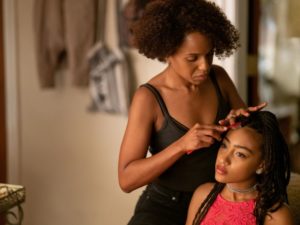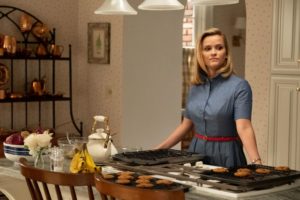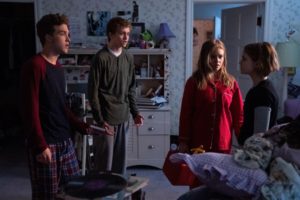Little Fires Everywhere is a Hulu limited series based on the 2017 best-selling novel from author Celeste Ng and created and developed by showrunner Liz Tigelaar. The show follows well-off journalist and landlord Elena Richardson (Reese Witherspoon) as she leads her picture-perfect family of 4 teenagers and husband in Shaker Heights, Ohio. Elena’s perfect life begins to unravel, spark, and become intertwined when enigmatic artist Mia Warren (Kerry Washington) and her daughter Pearl (Lexi Underwood) move into this suburb town of Cleveland. The series tackles issues from race, social class, status, identity, secrets, motherhood, immigration, abortion, adoption, and pre-conceived notions.

The perception, perspective, and point of view is accentuated and pin pointed through the editing of the series. Little Fires Everywhere utilized three editors in Tyler L. Cook, Amelia Allwarden, and Phyllis Housen. Cook bookended and edited the bulk of the series through “The Spark” (Ep.1), “Seventy Cents” (Ep. 3), “Picture Perfect” (Ep. 7), and “Find a Way” (Ep. 8).
The two main characters in Elena and Mia were polar opposites, but connected through a very diverse and dynamic tension. Cook distinguished, “Elena is very perfect, by the book, she’s scheduled down to the minute and wanted to reflect that in both the cinematography and the editing by having everything feel planned and uniform. We wanted our cuts to be very deliberate and precise. When we go to Mia, the camera was more handheld, we did a lot of jump cuts. Mia’s scenes felt more ephemeral, arterial, more artistic as opposed to rigid and precise. As far as establishing tension early on, we really prioritized leaving space for each character to have an internal reaction to what was happening in a scene. We really wanted those internal moments to help set up the tension and the dynamics between the two women and really let those things develop early on.”

The point of view shifted from episode to episode with an emphasis on a different character’s perspective. The editor expounded, “Mia’s character is very gruff, a no-nonsense person, and bit of a hard personality that we wanted to lean into that, almost in a misdirect way. Elena is so affable; it’s Reese Witherspoon and audiences are going to gravitate towards her and her point of view. We used that to our advantage and set Mia up as a polar opposite. As the story progresses, their storyline intersects by episode four and we wanted people to sympathize more with Mia from that point on, how things change, and go in the other direction. By the end of it, we’re seeing Elena unravel and we identify with the choices Mia is making as she becomes a lot more of a loving, caring caretaker to Izzy, Pearl, and everybody. At the same time, we always wanted to make sure that every character, we understood the reasons why they were doing what they were doing.”

The episodes presented multiple stories happening simultaneously between all the characters through emotional emphasis. “In the pilot, there is this intercut where those both mothers had a really big setback with their child. Izzy refused to play in the orchestra and Pearl had just gotten into a big argument with her mom because she was arrested by a security guard at the junkyard. Both mothers are trying to figure out what to do and how to approach their children. In the script, those scenes were separate scenes and they played one after the other. The emotional space that they both existed in really helped us see that they were the same. We used that as a bridge to intercut those two scenes and play off one another. Once we started doing that, they really allowed us to occupy the same emotional space and draw parallels between both stories in a much more efficient and emotional way. We have each individual story and then we have the third meaning that is created by the juxtaposition of the two. We wanted them to feel they were bleeding into each other and coalescing together,” the editor illuminated.

The first and last episode were connected through the imagery of the fire. Cook encapsulated, “It creates this bookend of everything we’re seeing before the fire leading up to the fire in episode eight as a flashback. When we put that scene in, we were feeling a different energy, a different vibe, and it allowed us to really bring in the threads of the later drama and tension. If we compare an image from the first episode and an image from the last episode, they look and feel like totally different shows. We made a very conscious choice of having that evolution take place. Part of it was due in part because of the seasons changing, we start in summer and end in winter. We let that be our guide in terms of how everything was developing from there. It’s a tricky balance of making it unique, but also making it feel of a whole.

The editing in Little Fires Everywhere explored dynamic tensions between two polar opposites people, while simultaneously providing audiences with an open-ended perspective to decipher their own perceptions regarding the characters, situations, issues, and handling decisions.
Editor Tyler L. Cook has previously been nominated for an Independent Spirit Award for Best Editing for his work on Sword of Trust. Cook’s other distinguishable television series credits include GLOW, Preacher, The Originals, The Vampire Diaries, and 90210.





